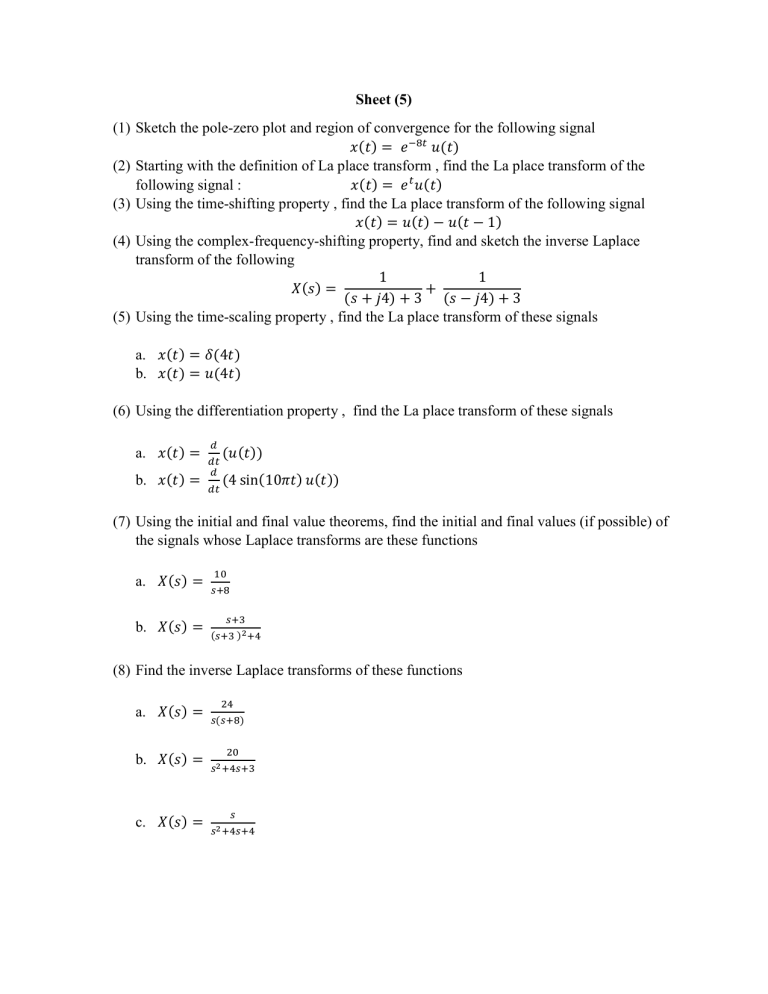
Sheet (5) (1) Sketch the pole-zero plot and region of convergence for the following signal 𝑥(𝑡) = 𝑒 𝑢(𝑡) (2) Starting with the definition of La place transform , find the La place transform of the following signal : 𝑥(𝑡) = 𝑒 𝑢(𝑡) (3) Using the time-shifting property , find the La place transform of the following signal 𝑥(𝑡) = 𝑢(𝑡) − 𝑢(𝑡 − 1) (4) Using the complex-frequency-shifting property, find and sketch the inverse Laplace transform of the following 1 1 𝑋(𝑠) = + (𝑠 + 𝑗4) + 3 (𝑠 − 𝑗4) + 3 (5) Using the time-scaling property , find the La place transform of these signals a. 𝑥(𝑡) = 𝛿(4𝑡) b. 𝑥(𝑡) = 𝑢(4𝑡) (6) Using the differentiation property , find the La place transform of these signals a. 𝑥(𝑡) = (𝑢(𝑡)) b. 𝑥(𝑡) = (4 sin(10𝜋𝑡) 𝑢(𝑡)) (7) Using the initial and final value theorems, find the initial and final values (if possible) of the signals whose Laplace transforms are these functions a. 𝑋(𝑠) = b. 𝑋(𝑠) = ( ) (8) Find the inverse Laplace transforms of these functions a. 𝑋(𝑠) = b. 𝑋(𝑠) = c. 𝑋(𝑠) = ( ) (9) Using the Laplace transform, solve these differential equations for t ≥ 0. a. 𝑥̇ (𝑡) + 10𝑥(𝑡) = 𝑢(𝑡) , 𝑥(0) = 1 b. 𝑥̈ (𝑡) − 2𝑥̇ (𝑡) + 4𝑥(𝑡) = 𝑢(𝑡) , 𝑥(0) = 0 𝑎𝑛𝑑 𝑥̇ (0) = 4 (10) Write the differential equations describing these systems and find and sketch the indicated responses : a. 𝑥(𝑡) = 𝑢(𝑡) , 𝑦(𝑡) 𝑖𝑠 𝑡ℎ𝑒 𝑟𝑒𝑠𝑝𝑜𝑛𝑠𝑒 , 𝑦(0) = 0 b. 𝑣(0) = 10 , 𝑣(𝑡) 𝑖𝑠 𝑡ℎ𝑒 𝑟𝑒𝑠𝑝𝑜𝑛𝑠𝑒 (11) Find the response 𝑦(𝑡) of the system whose impulse response ℎ(𝑡) to the excitation 𝑥(𝑡) where ℎ(𝑡) = 𝑒 𝑢(𝑡) , 𝑥(𝑡) = 3𝑒 𝑢(𝑡) − 12𝑒 𝑢(−𝑡) (12) Using the integral definition find the the unilateral Laplace transform of these time Functions : a. 𝑔(𝑡) = 𝑒 𝑢(𝑡) b. 𝑔(𝑡) = sin(𝜔 𝑡) 𝑢(𝑡) (13) Using the unilateral la place transform properties find the unilateral Laplace transforms of the following functions : a. 𝑔(𝑡) = 5 sin 2𝜋(𝑡 − 1) 𝑢(𝑡 − 1) b. 𝑔(𝑡) = 2 cos(10𝜋𝑡) cos(100𝜋𝑡) 𝑢(𝑡) c. 𝑔(𝑡) = 𝑢(𝑡 − 2) d. 𝑔(𝑡) = ∫ 𝑢(𝜏) 𝑑𝜏 (14) Given 𝑒 𝑢(𝑡) ↔ 𝐺(𝑠) , find the inverse Laplace transforms of : a. 𝐺 b. 𝐺(𝑠 − 2) + 𝐺(𝑠 + 2) c. ( )


